Over the years, there have been at least five record labels with the name "Apollo." Two of these
existed briefly in the 1920s, before the most famous label by that name, which is the subject of this
page. Two more Apollo Records labels existed later, one for a brief time out of Seattle, and a more
current label in Belgium.
The Apollo Records discussed here was formed in New York City in 1944 by Ike and Bess Berman, with
Hy Siegel and Sam Schneider. The label recorded rhythm and blues, gospel, jazz, and popular music.
Kenwood was a reissue label with issues given the same number as the original Apollo release,
although it is not known if all the Apollo LPs were reissued on Kenwood. The albums were all mono to
our knowledge.
 The Bermans ran the label, particularly Bess Berman. The Bermans started issuing 78-rpm discs from
their record store, the Rainbow Record Shop on 125th Street in Harlem, near the Apollo Theater, as
early as 1943. The first discs did not bear the Apollo name, but they soon started using the name of the
famous theater nearby, even though they had no business connection with the Apollo Theater. The logo
on the records started as a drawing of a statue of the Greek god Apollo (as far as anyone knows what he
looked like!), with "APOLLO" in large letters in front of the neck and shoulders of the drawing. This was
the "classic" Apollo Records logo, which remained on their records until the late 1950s.
The Bermans ran the label, particularly Bess Berman. The Bermans started issuing 78-rpm discs from
their record store, the Rainbow Record Shop on 125th Street in Harlem, near the Apollo Theater, as
early as 1943. The first discs did not bear the Apollo name, but they soon started using the name of the
famous theater nearby, even though they had no business connection with the Apollo Theater. The logo
on the records started as a drawing of a statue of the Greek god Apollo (as far as anyone knows what he
looked like!), with "APOLLO" in large letters in front of the neck and shoulders of the drawing. This was
the "classic" Apollo Records logo, which remained on their records until the late 1950s.
The Apollo labels over the years were many and varied, especially as to color.
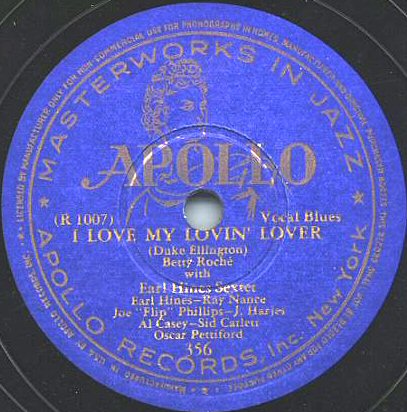
|
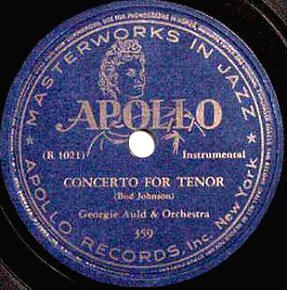
|
The 78s started in 1944 in the 350 jazz (later, blues) series, which ran all the way to #541 in 1959. The
earliest 78s had a blue label with gold print (far left) or a dark blue label with gold print (near left). Around
the edge of the label was a thin gold circle. Inside the circle, jazz sides featured the slogan
"MASTERWORKS IN JAZZ" around the top of the label, with "APOLLO RECORDS, Inc. New York"
around the bottom. Outside the circle in tiny lettering was legal boilerplate noting the record was for non-
commercial use in homes only, as well as other legalese.
|
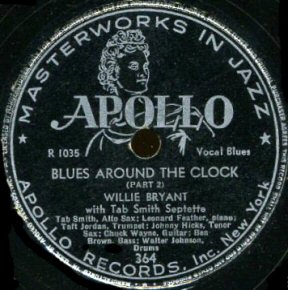
|
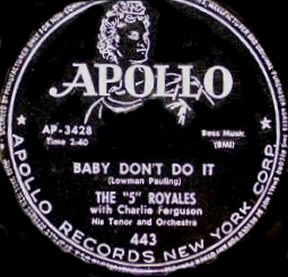
|
Later in the 350 series, a black label was used with the same graphics. The label at far left shows the
"MASTERWORKS IN JAZZ" label, while the rhythm and blues side shown at near left did not have it.
|
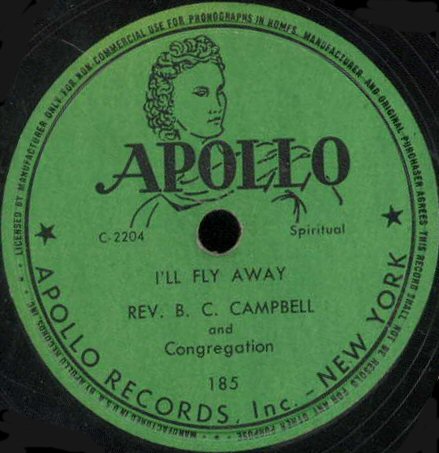
|
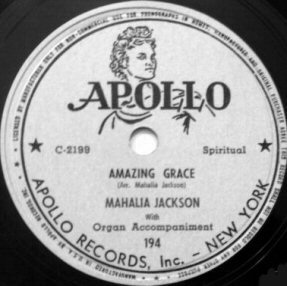
|
The 100 series was another of the early Apollo 78 series. It was for spirituals, gospel music, and country
and western music. The series ran from 1944 to 1956, with the last issued number being #316. Very
early labels were green with black print, and later white with black (or purple) print. These had the same
graphics as the jazz/blues series, with no slogan at the top of the circle.
|
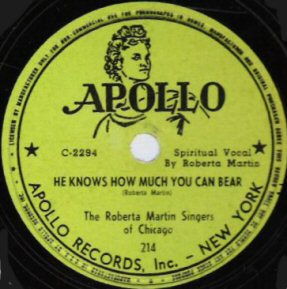
|
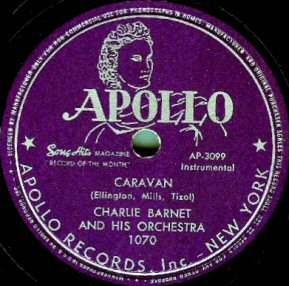
|
Also in the spiritual/country series, a yellow-green label was used (far left) with the same graphics. The
1000 series, which was for big band music and pop vocals, used a purple label with gold print (near left),
also with the same graphics as the other series.
|
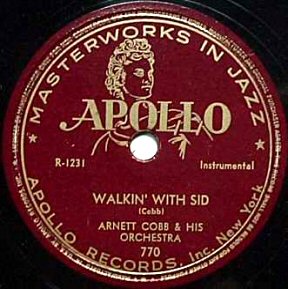
|
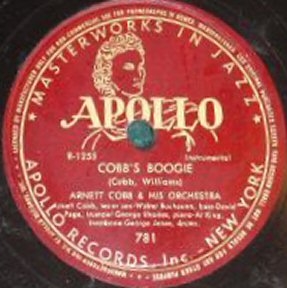
|
The 750 series was a jazz series, around when the label started in 1944. The labels for this series were
maroon (far left) or red (near left), with the same graphics. The 750 series lasted until #825 in 1950.
|
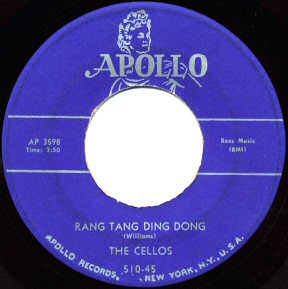
|
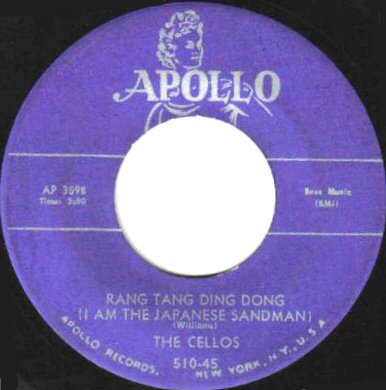
|
Apollo started issuing their singles on 45 rpm in 1951. From 1951-1958, singles had a blue label with
silver print. Original issues of #510, the Cellos' "Rang Tang Ding Dong" (far left) did not have the subtitle
"(I Am The Japanese Sandman)" that was later added. For a short time in 1959, the label design
changed to a yellow label with a diamond logo (see LP examples below).
|
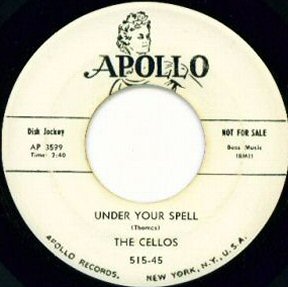
|
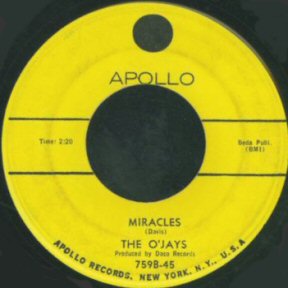
|
Deejay copies of the early 1950s 45 singles had a white label with black print (far left). In 1959, Apollo
stopped issuing singles for about two years. When they recommenced in late 1960, they changed the
label design to yellow with a black spot as a logo. Many of the records issued during the 1960-1962
period were reissues of earlier records.
|
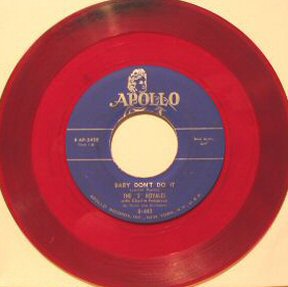
|
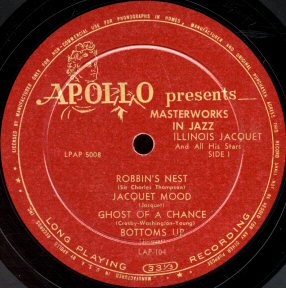
|
Red vinyl issues of some of the early 45s are known (far left), but many seen today are reproductions.
The early 10-inch albums featured a red label with the Apollo logo with the drawing of the bust of Apollo
at the top left of the label. Albums used the logo as part of "Apollo Presents..." followed by the album
name.
|
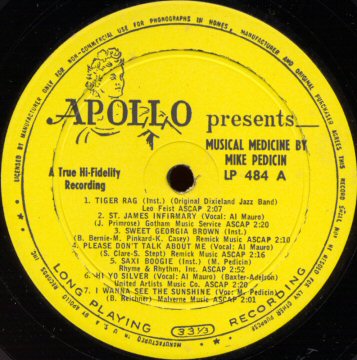
|
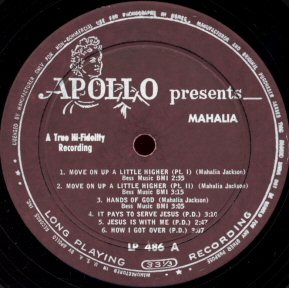
|
When the 12-inch albums began with LP-474, Apollo used a yellow label with the drawing of Apollo,
using the same graphics as the red 10-inch label (far left). They also used a brown or purple variation of
this label with the Apollo drawing (near left) until the diamond logo below was introduced in 1959.
|
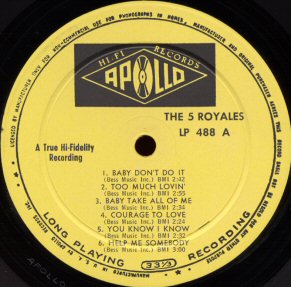
|
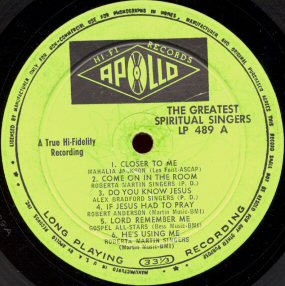
|
The "diamond logo" label was introduced in late 1959. Both yellow and green versions of the diamond
logo labels are known, as well as the purple diamond label shown below. This label lasted until
approximately late 1960.
|
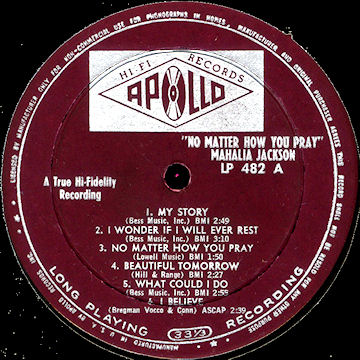
|
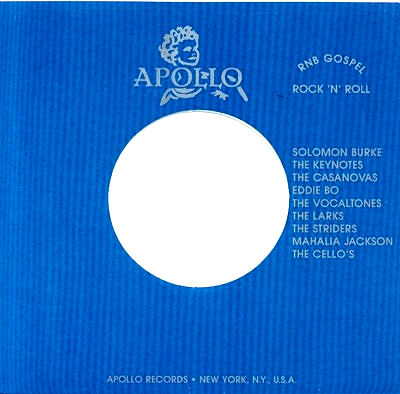
|
The purple diamond label (far left) was used for a Mahalia Jackson album. Apollo also had a custom
sleeve for 45s; the example at near left is a reproduction.
|
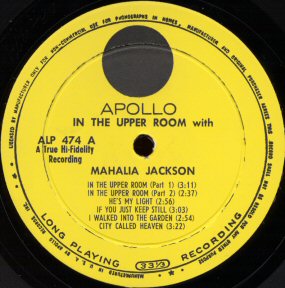
|
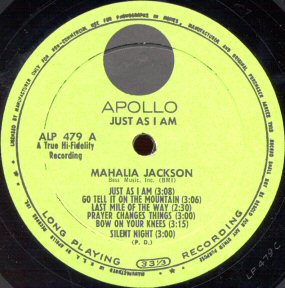
|
As with the diamond logo labels, the "dot" logo label debuted about late 1960 in both yellow and
green colors (as well as the purple version pictured below). Many of the earlier albums were reissued
with these labels during the 1960-62 period and later.
|
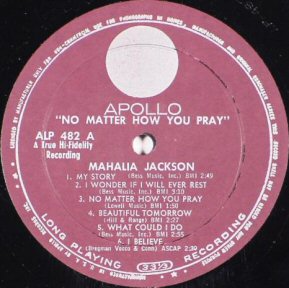
|
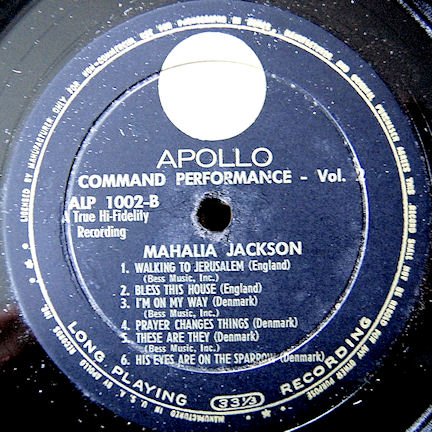
|
At far left is the purple version of the "dot" label used in 1960-62. There was also a light blue version of
the "dot" label with silver print and a silver dot. A yellow label with black lettering, with
"Apollo" in very elaborate straight black letters across the top, is also known (but not pictured). One side
of each letter is made up of three parallel black lines, and underneath the Apollo lettering are two
parallel black lines going across the label above the spindle hole. At near left, Apollo used a black label
with gold print with the "dot" for the two albums in the ALP-1000 series.
|
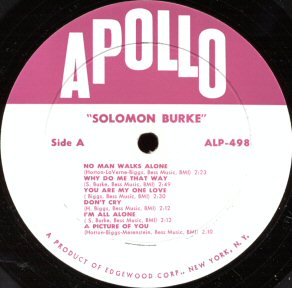
|
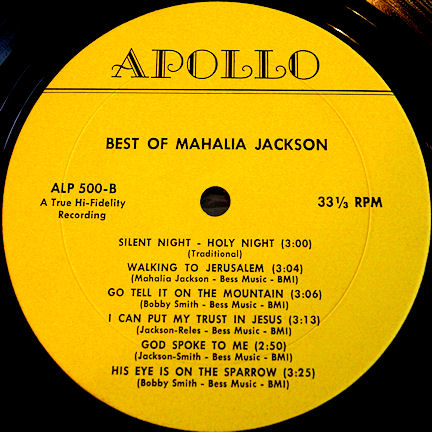
|
A label (near left)
crediting "Edgewood Corporation" of New York is also known, and is believed to be a reissue label,
although both ALP-498 and ALP-499 are known with this label. It is a white label with the top third in
red/purple with "APOLLO" in white block letters. The bottom two-thirds of the label is white, with red
print. At near left is the yellow label used for ALP-500, The Best of Mahalia Jackson, which has
the same tracks as ALP-499 and is believed to be a later album not legitimately issued by Apollo
Records.
|
 The Bermans ran the label, particularly Bess Berman. The Bermans started issuing 78-rpm discs from
their record store, the Rainbow Record Shop on 125th Street in Harlem, near the Apollo Theater, as
early as 1943. The first discs did not bear the Apollo name, but they soon started using the name of the
famous theater nearby, even though they had no business connection with the Apollo Theater. The logo
on the records started as a drawing of a statue of the Greek god Apollo (as far as anyone knows what he
looked like!), with "APOLLO" in large letters in front of the neck and shoulders of the drawing. This was
the "classic" Apollo Records logo, which remained on their records until the late 1950s.
The Bermans ran the label, particularly Bess Berman. The Bermans started issuing 78-rpm discs from
their record store, the Rainbow Record Shop on 125th Street in Harlem, near the Apollo Theater, as
early as 1943. The first discs did not bear the Apollo name, but they soon started using the name of the
famous theater nearby, even though they had no business connection with the Apollo Theater. The logo
on the records started as a drawing of a statue of the Greek god Apollo (as far as anyone knows what he
looked like!), with "APOLLO" in large letters in front of the neck and shoulders of the drawing. This was
the "classic" Apollo Records logo, which remained on their records until the late 1950s.




























 On to the Apollo Album Discography, Part 2 Reissues
On to the Apollo Album Discography, Part 2 Reissues
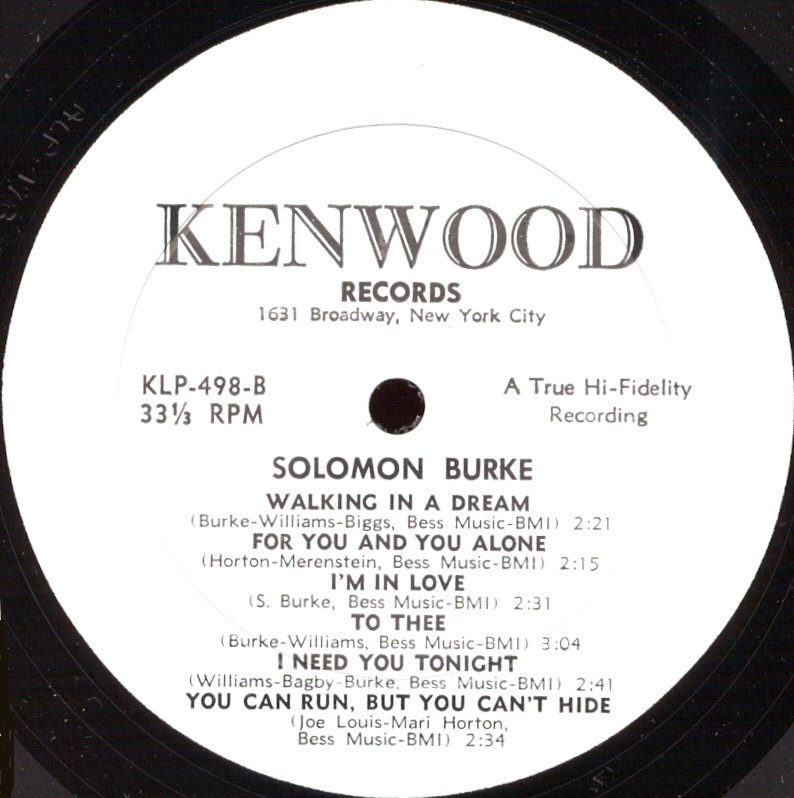 On to the Kenwood Album Discography
On to the Kenwood Album Discography Back to the Discography Listings Page
Back to the Discography Listings Page